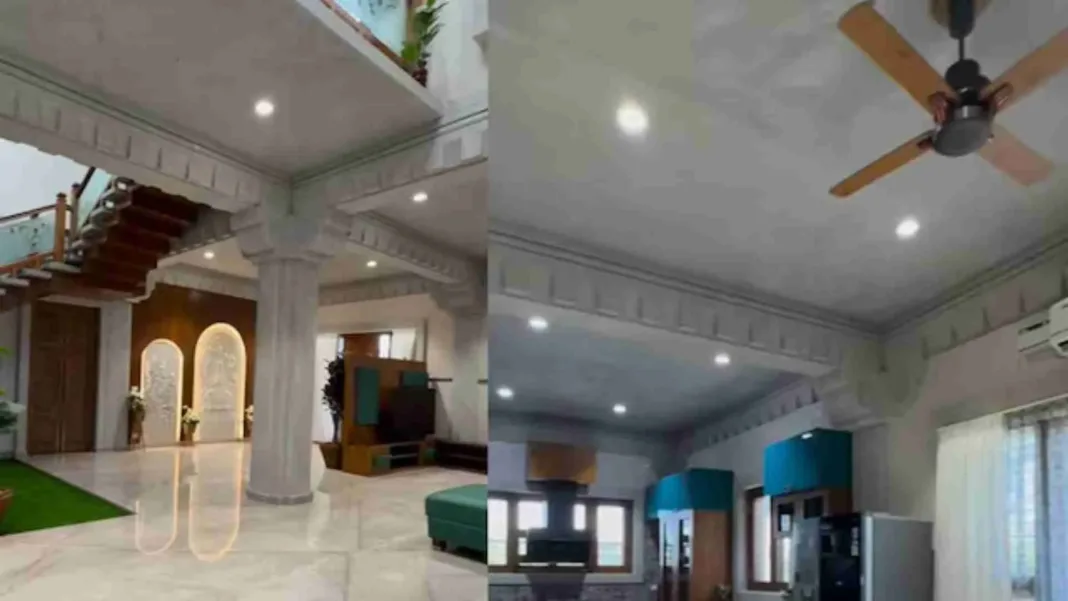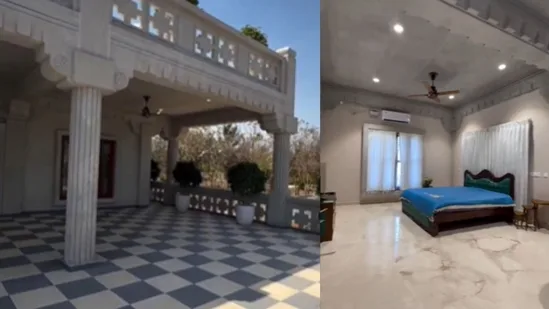A house built without cement is an unusual concept, yet a homeowner in Bengaluru has accomplished exactly that. This zero-cement stone house, constructed using traditional interlocking techniques, has gained widespread attention after content creator Priyam Saraswat shared a video showcasing the structure. The homeowner claims it to be the world’s first of its kind, designed for longevity and environmental sustainability.
Architectural Design and Construction Techniques
This house is constructed using precisely cut stone blocks, including grey granite and sandstone, arranged through interlocking methods. The absence of cement, adhesives, or blasting ensures a pure masonry structure, reminiscent of historical stone architecture. Interlocking stone construction, commonly seen in ancient temples and forts, distributes weight efficiently while allowing for structural flexibility and durability.
The design emphasizes natural load-bearing capabilities, where each stone piece interlocks to form a stable and enduring framework. Unlike modern reinforced concrete structures that rely on binding agents, this house depends entirely on the precision of its masonry, ensuring resilience against environmental and seismic forces.
Step-by-Step Construction Process Using the Interlocking Method
- Material Selection – Sourcing precisely cut granite or sandstone for uniform interlocking.
- Foundation Laying – Arrange the first stone layer tightly for a solid base.
- Wall Construction – Stack stones in an interlocking pattern without cement.
- Roofing – Use stone slabs or lightweight alternatives with structural support.
- Finishing Touches – Apply protective coatings, insulation, and install openings.
The Structural Integrity of Interlocking Stone Architecture
The success of this technique lies in its structural behavior. Interlocking stone systems transfer loads efficiently, distributing stress evenly across the structure. This prevents localized failures, unlike reinforced concrete, which is prone to cracking and requires regular maintenance. Additionally, the weight of stone provides inherent stability, making such constructions highly resistant to wind and seismic activity.
Moreover, the porosity and density of stone help regulate indoor temperatures, providing passive cooling and reducing energy consumption. This natural thermal insulation makes stone houses particularly effective in varying climates.
Revival of Traditional Architectural Practices
Historically, interlocking stone structures have been used in temple architecture, stepwells, and forts, many of which have stood for centuries without significant deterioration. This construction method relies on finely crafted joinery rather than binding materials, a testament to the engineering expertise of ancient builders. By reviving these techniques, this project highlights the potential of historical construction methods in contemporary architecture.
Additionally, the absence of cement eliminates concerns related to material degradation over time, such as cracking due to thermal expansion or corrosion of embedded reinforcements. Stone structures are known for their longevity, withstanding environmental changes without the need for frequent repairs.
Social Media Reaction and Public Debate
The video has sparked a mix of reactions online. Many users praised the house for its sustainability and innovative approach. Some commenters highlighted the revival of ancient Indian architectural techniques, noting that temples built centuries ago using similar methods have withstood the test of time.
However, others raised concerns about the practicality of such a structure. Some questioned how well the house would adapt to different climate conditions, particularly extreme heat and cold. Others pointed out that while the house avoids cement, it still relies on quarrying stone, which has its own environmental impact.
One of the most debated aspects is the claim of originality. Some users argue that interlocking stone construction has existed for centuries and should not be considered an innovation. Others questioned the feasibility of scaling this construction method for urban developments where space and cost constraints are significant.

Architectural Implications for Sustainable Building Design
As architectural practices shift towards sustainability, interlocking stone structures offer an alternative to high-carbon materials. This method reduces reliance on industrially processed materials like cement and steel while promoting the use of natural, locally sourced stone.
Future advancements in prefabricated stone elements and modular masonry could enhance the efficiency of this technique, making it more accessible for modern construction. Architects exploring net-zero and passive design strategies may find interlocking stone construction a viable option for creating resilient, low-maintenance buildings.
Challenges in Adapting Interlocking Stone Construction for Modern Use
While the architectural benefits of interlocking stone construction are evident, certain challenges must be addressed before it can be widely adopted:
- Material Sourcing and Processing: The precision required for interlocking stones necessitates advanced stone-cutting techniques, which may increase construction time and cost.
- Structural Limitations: While effective for low- and mid-rise buildings, interlocking stone construction may require additional support systems for high-rise applications.
- Urban Adaptability: The method’s reliance on stone blocks limits its feasibility in dense urban areas where space and weight constraints favor lightweight materials.
- Construction Expertise: Skilled labor is essential to execute interlocking masonry accurately, making it important to develop training programs to support widespread adoption.
Conclusion
The zero-cement stone house in Bengaluru reintroduces a time-tested architectural technique that challenges modern construction norms. While it may not replace conventional building methods entirely, it presents a compelling case for integrating traditional masonry with contemporary architectural solutions. As discussions on sustainable architecture continue, interlocking stone construction could serve as an inspiration for future projects aiming to balance structural integrity, environmental impact, and long-term durability.

